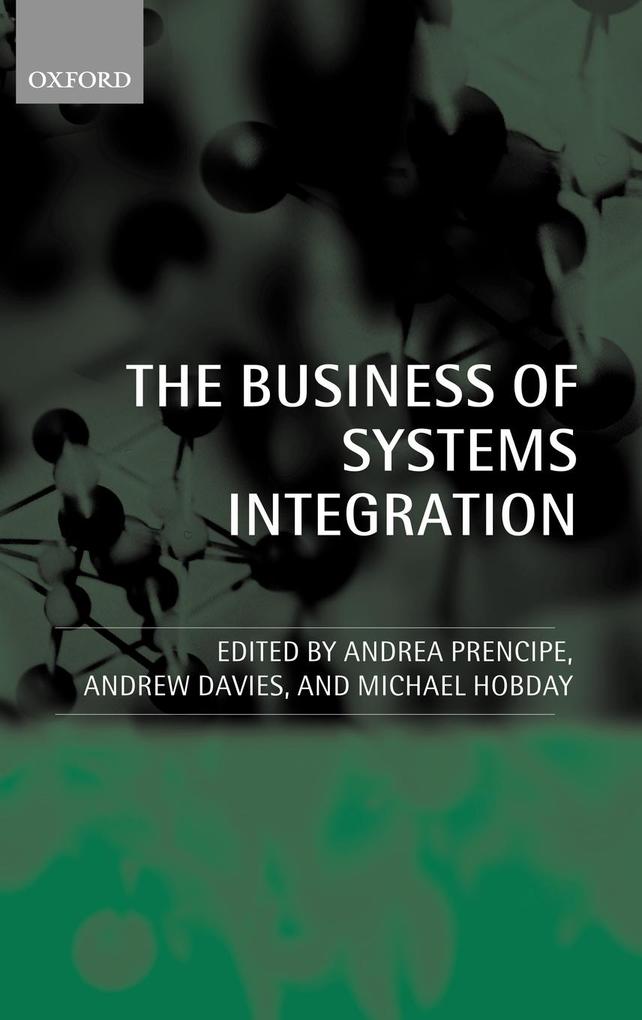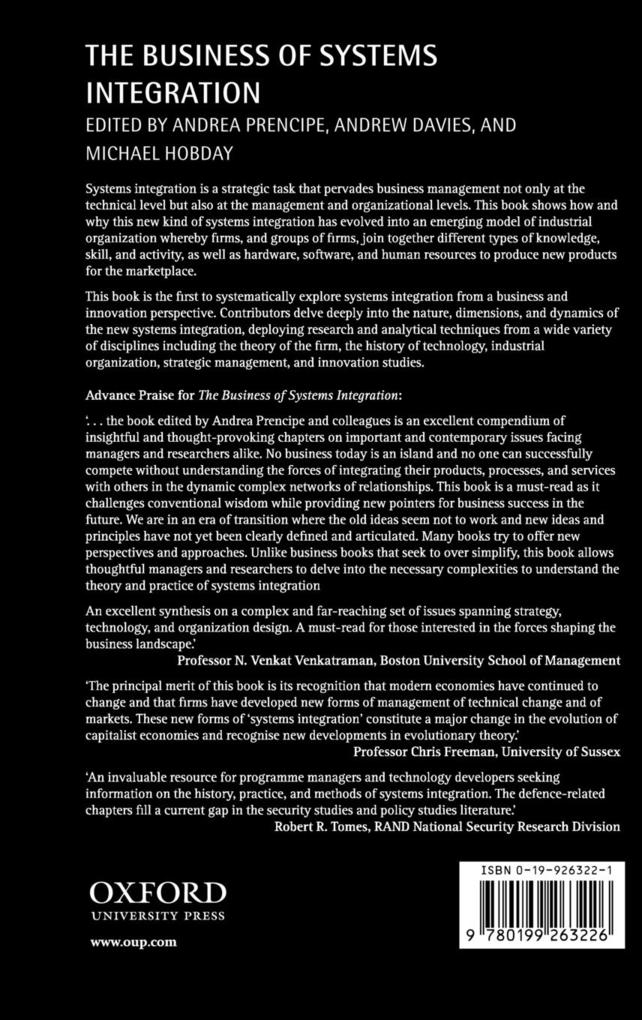
Zustellung: Mo, 28.07. - Fr, 01.08.
Versand in 2 Wochen
VersandkostenfreiBestellen & in Filiale abholen:
Over the past decade or so, systems integration has become a key factor in the operations, strategy and competitive advantage of major corporations in a wide variety of sectors (i.e. computing, automotive, telecommunications, military systems and aerospace). Systems integration is a strategic
task that pervades business management not only at the technical level but also at the management and strategic levels. This book shows bow and why this new kind of systems integration has evolved into an emerging model of industrial organization whereby firms, and groups of firms join together
different types of knowledge, skill and activity, as well as hardware, software and human resources to produce new products for the marketplace. This book is the first to systematically explore systems integration from a business and innovation perspective. Contributors delve deeply into the nature,
dimensions and dynamics of the new systems integration, deploying research and analytical techniques from a wide variety of disciplines including the theory of the firm, the history of technology, industrial organization, regional studies, strategic management, and innovation studies. This wealth of
research capability provides deep insights into the new model of systems integration and supports this with an abundance of empirical evidence. The book is organized in three main parts. The first part focuses on the history of systems integration. Contributors trace the early history of systems
integration using different industrial examples. The second part presents theoretical and analytical aspects of systems integration. Contributions concentrate on the regulatory and cognitive features of systemsintegration, the relationships between systems integration and regional competitive
advantage, and the way in which systems integration supports the competitive advantage of firms. The third part takes industry and firm-level approaches. Contributions focus on different
task that pervades business management not only at the technical level but also at the management and strategic levels. This book shows bow and why this new kind of systems integration has evolved into an emerging model of industrial organization whereby firms, and groups of firms join together
different types of knowledge, skill and activity, as well as hardware, software and human resources to produce new products for the marketplace. This book is the first to systematically explore systems integration from a business and innovation perspective. Contributors delve deeply into the nature,
dimensions and dynamics of the new systems integration, deploying research and analytical techniques from a wide variety of disciplines including the theory of the firm, the history of technology, industrial organization, regional studies, strategic management, and innovation studies. This wealth of
research capability provides deep insights into the new model of systems integration and supports this with an abundance of empirical evidence. The book is organized in three main parts. The first part focuses on the history of systems integration. Contributors trace the early history of systems
integration using different industrial examples. The second part presents theoretical and analytical aspects of systems integration. Contributions concentrate on the regulatory and cognitive features of systemsintegration, the relationships between systems integration and regional competitive
advantage, and the way in which systems integration supports the competitive advantage of firms. The third part takes industry and firm-level approaches. Contributions focus on different
Inhaltsverzeichnis
- Preface
- 1: Michael Hobday, Andrea Prencipe, and Andrew Davies: Introduction
- Part I: The History of Systems Integration
- 2: Harvey M. Sapolsky: Inventing Systems Integration
- 3: Stephen B. Johnson: Systems Integration and the Social Solution of Technical Problems in Complex Systems
- 4: Fredrik Tell: Integrating Electrical Power Systems: From Individual to Organizational Capabilities
- 5: Keith Pavitt: Specialization and Systems Integration: Where Manufacture and Services Still Meet
- Part II: Theoretical and Conceptual Perspectives on Systems Integration
- 6: Giovanni Dosi, Michael Hobday, Luigi Marengo, and Andrea Prencipe: The Economics of Systems Integration: Towards an Evolutionary Interpretation
- 7: Andrea Prencipe: Corporate Strategy and Systems Integration Capabilities: Managing Networks in Complex Systems Industries
- 8: W. Edward Steinmueller: The Role of Technical Standard in Coordinating the Division of Labour in Complex Systems Industries
- 9: Massimo Paoli: The Cognitive Basis of System Integration: Redundancy of Context Generating Knowledge
- 10: Henry Chesbrough: Towards a Dynamics of Modularity: A Cyclical Model of Technical Advance
- Part III: Competitive Advantage and Systems Integration
- 11: Michael H. Best: The Geography of Systems Integration
- 12: Mari Sako: Modularity and Outsourcing: The Nature of Co-Evolution of Product Architecture and Organization Architecture in the Global Automotive Industry
- 13: Akira Takeishi and Takahiro Fujimoto: Modularization in the Car Industry: Inter-Linked Multiple Hierarchies of Product, Production, and Supplier Systems
- 14: Eugene Gholz: Systems Integration in the US Defence Industry: Who Does It and Why Is It Important?
- 15: Maureen McKelvey: Changing Boundaries of Innovation Systems: Linking Market Demand and Use
- 16: Andrew Davies: Integrated Solutions: The Changing Business of Systems Integration
Produktdetails
Erscheinungsdatum
29. Januar 2004
Sprache
englisch
Seitenanzahl
396
Herausgegeben von
Andrea Prencipe, Andrew Davies, Michael Hobday
Verlag/Hersteller
Produktart
gebunden
Gewicht
709 g
Größe (L/B/H)
244/164/29 mm
ISBN
9780199263226
Pressestimmen
Systems integration has become a core strategic capability for businesses seeking competitive advantage in technologically complex, globalized industries. The editors of this volume have gathered together the best thinking from around the world on this vital subject. The result is an outstanding, pathbreaking book, filled with valuable insights for practitioners and researchers alike. Richard K. Lester, Director, Industrial Performance Center
Bewertungen
0 Bewertungen
Es wurden noch keine Bewertungen abgegeben. Schreiben Sie die erste Bewertung zu "The Business of Systems Integration" und helfen Sie damit anderen bei der Kaufentscheidung.










